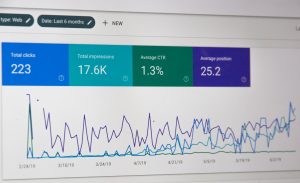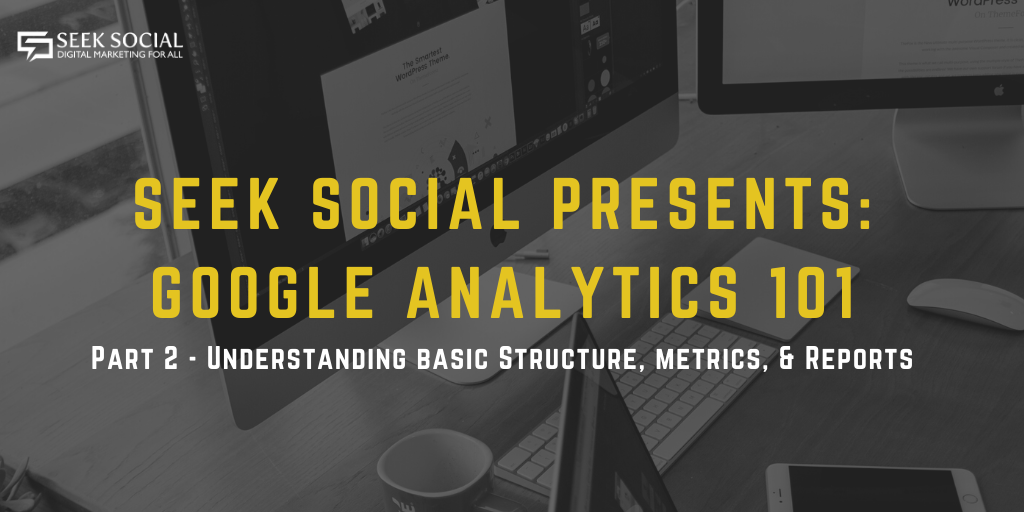15 June 2020
Google Analytics: A Step By Step Guide by Your SEO Expert – Part 2!
Your SEO expert promised you more great Google Analytics content, and now it’s time for us to deliver on that promise. Last time we went through the account setup process, but in part 2 of our in-depth look at Google Analytics can begin to show you what the Seek Social team calls ‘the fun stuff’. Some of what we’re going to talk about today may seem pretty boring to the uninitiated… However, to an SEO expert team like ourselves, it’s all really cool stuff! We love to see analytics reports, to understand them, to spot and resolve the problems they highlight to us, and to see the numbers change and trend in the right direction as we work.
It’s our hope that – even if you aren’t bitten by the same bug that our SEO expert team has been – this week’s blog will at least de-mystify the more common and most crucial Google Analytics metrics, graphs, charts and reports. That won’t turn you into an SEO expert too, but it is the kind of understanding which we talked about last week – the kind of understanding that a modern business owner needs in order to do business effectively online. So, without further ado, lets dive right in, as part 2 of Seek social’s in-depth look at Google Analytics starts right now!
Section 1: Accounts, Properties, Views & Organizations Explained
If you’re following on directly from where our SEO expert team left things in part one of this guide, then you will have just created an account, gotten a property tracking code, and be in the default view for that property. What does all of that mean though – ‘properties’, ‘views’, ‘accounts’ etc.?

‘Properties’ are next level up, and put simply, these are the individual sites that you want Google Analytics to collect data for. You get 50 of these per account. Our SEO expert team know that on the face of it it may seem like you’d only ever need one, but that’s not always the case. If you post your blog on 2 different platforms, if you use separate websites for promotion and sales, or if you’re an international operation and you have a number of localised country- or region-specific sites (a setup that the Seek Social SEO expert team are more than familiar with) then each different URL will need to be its own property.
Moving up another level, we have the ‘Account’. We went through this last week so we won’t go into it in too much detail here. Your SEO expert knows that there is one more level above ‘account’ – that of ‘Organisation’. This highest level may not be needed depending on how your business is structured, nevertheless, it can be useful for larger businesses.
Imagine a situation where area or department I.T. managers have each set up accounts to track the properties they’re responsible for, but they need to report back to the board of directors, and the board of directors need access to data from all of these accounts. In this case, tying all of the accounts together under one ‘organisation’ and giving the board access to the organisation may be the way forward.
Section 2: A Word on Best Practice With Views

Essentially, you can’t look at anything retroactively. As a result, the SEO expert team at Seek Social recommend setting up two extra ‘staple’ views any time you hook Analytics up to a new property. By default, Google Analytics gives you an ‘All Web Site Data’ view. Keep this, and DO NOT MODIFY IT – it’s your insurance against data loss. This view records everything from the moment Analytics setup is complete. So, if circumstances change and you decide you DO need to see previous data for a metric you haven’t been recording somewhere else – or if you accidentally turn something off in another view and don’t notice – you can use this view to see what those values were.
Next, our SEO expert team advises creating a new view that includes all the data you want to see in your reports – a view that shows you what you want to see, but none of the extraneous stuff that you don’t need – your ‘Master View’. The third view you’ll want is a ‘Test View’. This is the place to try out changes and verify that new setups provide the info you’re expecting from them without messing with views that are working well for you, and potentially breaking your reporting system.
 Section 3: Introducing the Audience Overview
Section 3: Introducing the Audience Overview
That’s setup dealt with – time for the fun stuff! As a starting point the SEO expert team at Seek Social would introduce you to the ‘Audience Overview’ report. This is probably the most commonly seen of Google Analytics’ reporting pages, and tells you about the people visiting your site. How many of them there are, where they come from, what language they speak, how many of them come back, and more!
Section 4: Key Dimensions & Metrics Explained by Your SEO Expert
The SEO expert team at Seek Social know that the information on this page is probably the most important in all of Google Analytics too. As a result, it’s important that you as a business owner understand what’s going on here as well as your SEO expert does. So, below we’ve provided a handy ‘plain English’ guide explaining what all of the individual metrics visible in this report are showing you.
Users / New Users
Put simply, this is the number of people that have been visiting your site. Google Analytics leaves a cookie on your device the first time you visit a site, and it uses this cookie to differentiate between ‘new’ and ‘returning’ users – since, If you already have a cookie, Analytics knows that you must have been to this site before, and are a ‘returning user’. Our SEO expert team know that there are some circumstances in which ‘new users’ will have visited a site before, but on the whole this is a very reliable measurement of the traffic that your site is getting.
Sessions
A new ‘session’ is recorded any time someone visits your website, or returns to it after 30 minutes of being away. This metric is essentially a counter of how many individual times someone came to your site for some reason and is again a really good measure of popularity. Why? Because if someone visits your site seven times in a given time period, the ‘users’ metric will still only record 1 returning user. This ‘sessions’ metric however, will log all seven visits for you – giving you a clearer picture of how popular you are with your repeat visitors.
Avg Sessions per user
This is a simple average of the two metrics explained above. The insight this metric can give you is a measure of how likely your site is to entice someone back, and how likely it is that a visitor will become a returning visitor. The higher the number, the greater the likelihood.

This really doesn’t require an SEO expert to explain, but the ‘Page Views’ metric counts up the number of times a page on your site was loaded. On the audience overview report this – like all the other metrics we’ll discuss today – is presented as an overall site-wide total for the date range selected. However, elsewhere in Google Analytics you can also see a page by page breakdown of this total. This is another metric that informs you on the behaviour of your users – this time recording how many individual pages they look at, as opposed to how many times they’ve visited the site as a whole.
Bounce Rate
The one thing that our SEO expert team want you to take away from this metric is that here, lower numbers are better. ‘Bounce rate’ is a measure of how often users load one page on your site and then leave again quickly. For a search engine, this is the behaviour pattern of someone who did not get what they were looking for from your page – and pages delivering such an experience should be moved down the rankings.
Avg. Pages Per Session
This is a useful average to keep track of, as again, it lets you build a picture of your average visitor. Generally here, the more pages site users visit, the better, as anyone who is not finding what they need on your site will leave pretty quickly. Higher numbers therefore indicate that people are staying and at least having a look around, which in turn means there must be at least something about your site that they like. You’ll need other metrics to find out exactly what that is, but the more you can retain your visitors for multi-page visits, the better.
Avg Session duration

When you need to beware though, is when the average session time doesn’t match up with the experience you want users to have. To use our previous examples, this could mean that your content isn’t retaining its audience, or that there is an issue with your ‘quick and simple’ purchase process.
Section 5: So, which metrics matter and what constitutes success?
That depends on what your goals are, as we’ve seen above. Our SEO expert team know that ‘success’ is a constantly shifting target depending on what you want to do with your business. We also know that different metrics will matter more or less depending on your goals, and as a result, its important to understand what each metric is showing you. If you can do that, then you know what metrics need to be part of your KPI’s, and what results for these metrics would indicate success for you.
Without that knowledge, Google Analytics remains just what it looks like at first – a sea of numbers that alone, are no use to you as a business owner… But with this knowledge, it’s a key tool that can help you find success, and make money online!
 Section 6: The Final Word From Your SEO Expert
Section 6: The Final Word From Your SEO Expert
So, there you have it, our beginner’s guide to Google Analytics, and using the insights it offers to boost your business’ profile (and profits) online. We certainly hope you’ve enjoyed learning about the suite – and if you have, then definitely keep your eye on our blog in the coming weeks. The Seek Social SEO expert team have similar guides for other key platforms and tools in the works and we can’t wait to bring them to you!
Finally, if you just can’t wait that long and you want even more great digital marketing content and tips from your SEO expert in Bury, by all means browse through our blog archive, or alternatively, follow us on Instagram, Facebook, LinkedIn and Twitter for more bite-sized chunks of advice!



 Section 3: Introducing the Audience Overview
Section 3: Introducing the Audience Overview
 Section 6: The Final Word From Your SEO Expert
Section 6: The Final Word From Your SEO Expert